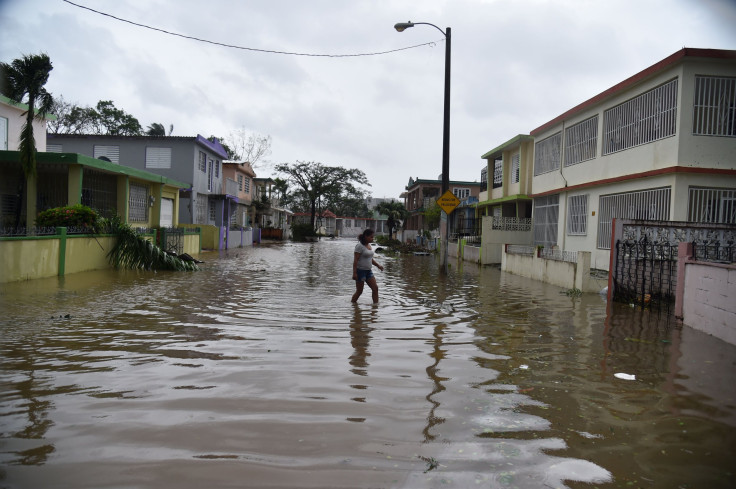
Hurricane Maria made landfall in Puerto Rico on Wednesday morning as a Category 4 storm with maximum sustained winds of 155 mph. Although at 5 p.m. ET, Maria had weakened significantly to a Category 2 storm with maximum sustained winds of 110 mph, it left a trail of devastation in the island, ripping roofs off buildings, filling homes with water, and knocking out power to the entire population.
"Definitely Puerto Rico — when we can get outside — we will find our island destroyed," Puerto Rico's emergency management director, Abner Gomez, said at a midday news conference, adding that 100 percent of the island is without electricity. "The information we have received is not encouraging. It's a system that has destroyed everything it has had in its path."
The storm also ripped trees out of the ground and caused widespread flooding. "This is total devastation," said Carlos Mercader, a spokesman for Puerto Rico's governor. "Puerto Rico, in terms of the infrastructure, will not be the same. ... This is something of historic proportions."
Much of the island remained under a hurricane warning late Wednesday afternoon as Maria churned just 25 miles off the northeastern coast. "The wind threat has decreased," the National Hurricane Center said, but the threat of rain-gorged floods remains "devastating to catastrophic," it said. Airports in San Juan, Aguadilla and Ponce were ordered closed until Friday at the earliest because of flooding and debris, authorities said.
“This is just the beginning,” Governor Ricardo Rosselló said in an interview with El Nuevo Día, the largest daily newspaper in Puerto Rico. “We know there are severe damages along different rivers and reservoirs, and water has overflowed from riverbanks, causing flooding,” he added.
El peligro continúa - hay aviso de INUNDACIONES para TODO Puerto Rico. Permanezcan en lugares seguros.
— Ricardo Rosselló (@ricardorossello) September 20, 2017
Rosselló also announced a 6 p.m. to 6 a.m. curfew effective Wednesday until Saturday. “We find ourselves in a critical phase to help the thousands of Puerto Ricans who urgently need help and to determine the serious damages caused by Hurricane Maria,” he said in a statement.
Mantener el orden resulta fundamental para que autoridades puedan ejecutar apropiadamente.Por tanto, ordeno Toque de Queda efectivo hoy 6pm
— Ricardo Rosselló (@ricardorossello) September 20, 2017
El #ToqueDeQueda será de 6pm a 6am, desde hoy miércoles hasta el sábado a las 6am. Las excepciones se detallan en declaraciones emitidas. pic.twitter.com/shmcJf7uwW
— Ricardo Rosselló (@ricardorossello) September 20, 2017
Intense flooding was reported across the territory, particularly in San Juan, the capital, where many residential streets looked like rivers. The authorities warned weary residents not to let down their guard, because flash flooding and mudslides could be more deadly than the initial winds from the storm, now a Category 2 system.
Maria was a Category 5 hurricane — the strongest there is — when it hit the Caribbean on Monday night, killing at least seven people on the island of Dominica and one person on Guadeloupe. At least two people were injured. The Prime Minister of Dominica, Roosevelt Skerrit, reported "widespread devastation," including damages to his own house, which was shredded by the storm.
See posts, photos and more on Facebook.
Hartley Henry , a senior adviser to Prime Minister Skerrit, said Wednesday that authorities on the island were only now getting a good picture of the destruction left in Maria's wake. "Until late last night, there was no means of accessing, or even communicating with, Dominicans," Hartley said.
With daylight, he said, authorities found "tremendous loss of housing and public buildings," including severe damage to the island's main hospital, where "patient care has been compromised." In Dominica there’s no electricity or running water, and landline and cellphone services have been compromised. "In summary, the island has been devastated," Hartley added.
See posts, photos and more on Facebook.
As the storm continued on its northwestward path, tropical storm conditions were expected to begin on the southern coast of the Dominican Republic Wednesday afternoon, worsening into hurricane conditions. The storm would move on to the Turks and Caicos Islands and to the southeastern Bahamas Thursday morning, forecasters said.
© 2025 Latin Times. All rights reserved. Do not reproduce without permission.






